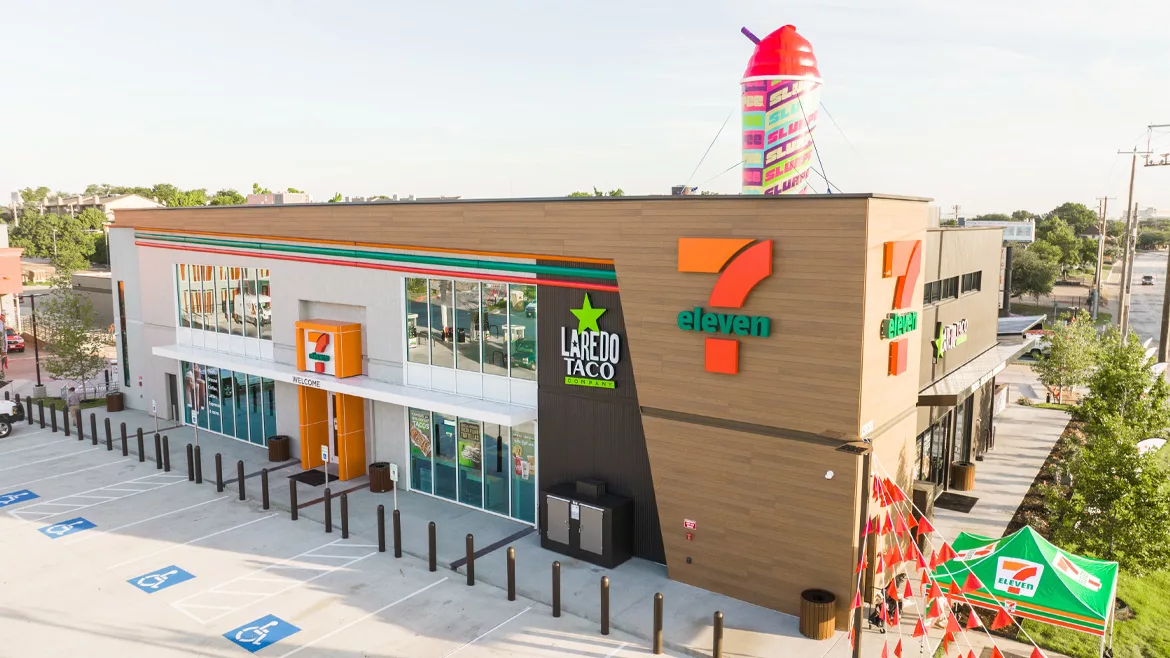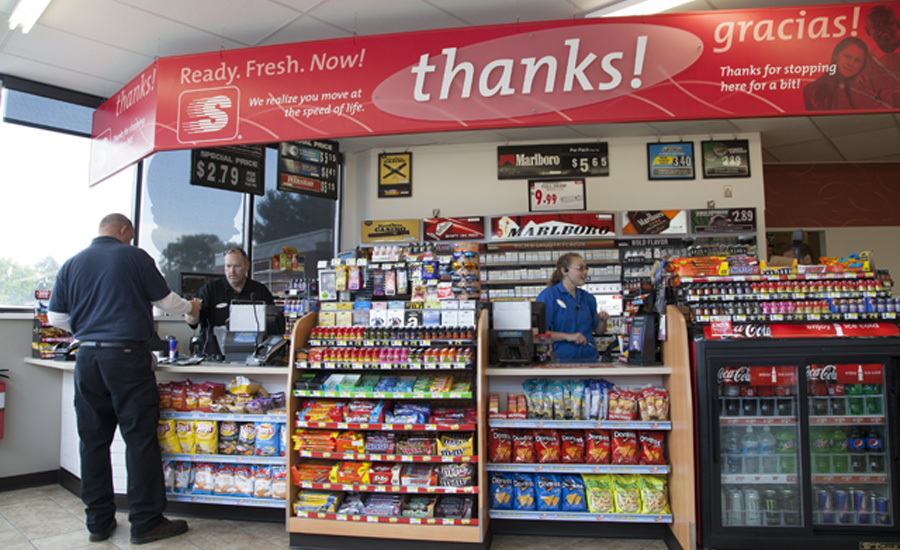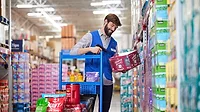Despite the pandemic, convenience stores continue to thrive
Operators look for new ways to make convenience stores live up to the name

Image courtesy of 7-Eleven
Convenience stores tend to live up to their name. There’s a pot of hot coffee ready to be grabbed during the morning rush, when you’ve only got five minutes to run in and out but you know you’ll be too tired without caffeine. There’s an array of sodas, sports drinks and energy drinks to choose from when you need an afternoon pick-me-up. Somehow, no matter what time it is, convenience stores are truly that: convenient.
During the past couple of years, the grab-and-go style of convenience stores has changed a bit, with people working hybrid schedules or working remotely. According to Jeff Lenard, vice president of strategic industry initiatives for the National Association of Convenience Stores (NACS), Alexandria, Va., convenience stores conduct nearly 160 million transactions every day. In other words, convenience stores serve about half the population of the United States each day.
“Those working at home or not working don’t feel the need to stop at stores during either rush hour,” Lenard says. “Instead, we are seeing a late-morning spike in traffic as people not commuting find the need to get out of the house to run errands or take a break. The same trend occurs in mid-afternoon.”

How the pandemic played out
Like most aspects of life, convenience stores were impacted by the COVID-19 pandemic. When travel was limited and consumers rarely left home, it left convenience stores in a unique position, scrambling to generate revenue in new ways while ensuring consumer safety.
Lenard describes the pandemic as having a “significant impact” on convenience store sales in 2020.
“In April 2020, fuels demand was down more than 40% as consumers stopped driving,” he says. “Demand was so light that oil futures were trading negative — a significant difference from 2022, when we experienced record-high gas prices as demand largely returned.”
Lenard notes that, during 2020, convenience stores saw a shift in the types of products sold.
“Convenience stores saw a large increase in beer and wine sales, as well as packaged beverage sales, as on-premise consumption at bars, restaurants and sporting events was significantly curtailed,” he says. “Meanwhile, c-store foodservice sales also suffered in 2020, as fewer stores were able to sell fountain beverages and coffee or meals, and fewer commuters also had a major impact on demand.”
Shahool Al Bari, lead industry analyst at IBISWorld, Los Angeles, says the pandemic “forced many operators, both small and large, to change aspects of their business.” Contactless payments and curbside pickup, for example, were implemented as safety measures, and as consumers found these factors useful, they stuck in place.
“Convenience stores have performed well over the past year due to the general retracement of health and safety protocols along with advancements in technology,” Al Bari says. “Convenience stores have added additional methods of convenience to attract consumers and provide them with a more streamlined service. According to IBISWorld, revenue grew 10% in 2021, following a 6% decline in 2020 due to COVID-19.”
NACS Lenard adds that the fuel aspect of convenience stores also is bouncing back as we emerge from the pandemic.
“Convenience stores sell approximately 80% of the motor fuels purchased in the United States and saw a return to the pumps as more consumers and commuters hit the road again in 2021, although below pre-pandemic levels in 2019,” he says. “Total fuel gallons sold increased 4% in 2021, but were still 7% below the level they were in 2019.”
Refreshment rage in c-stores
Joan Driggs, vice president of thought leadership at Information Resources Inc. (IRI), Chicago, says that many beverages that sell within the convenience store channel are thriving. Energy drinks are up 6.8% compared with a year ago (YA), carbonated soft drinks are up 7.6% vs. YA, water up 7% vs. YA and sports drinks are up 11.3% vs. YA.
“IRI data finds that consumers are opting for lower-priced beer, along with lower-priced cigarettes and other tobacco products,” Driggs says. “Together, these items make up more than half the total convenience store sales.”
Additionally, prepared cocktails are “trending up in the convenience channel,” Driggs says, as the sales are up 42.1% vs. YA.
“Following the path of hard seltzers, consumers appreciate the convenience and variety of prepared cocktails,” she points out. “They’re also more affordable than their on-premise (in bars and restaurants) counterparts, making experimenting with new flavors a plus. By their nature, convenience stores are an easy place for people to pop-in to purchase drinks to enjoy at home or someone else’s home.”
IBISWorld’s Al Bari echoes the sentiment that ready-to-drink (RTD) canned cocktails and seltzers will continue to “increase rapidly, according to various convenience store managers in an interview with CSP Magazine.” The IBISWorld lead analyst also notes that water and energy drinks have become “significantly popular,” especially with more better-for-you (BFY) energy drink choices.
“These drinks have become popular as they provide consumers with energy without too much sugar and calories,” Al Bari says. “Furthermore, many energy drinks have sugar-free or low-calorie options for more health-conscious consumers.”
According to data from IRI and CSP Magazine, the Top 3 performing drink categories within convenience stores are domestic beer at $14.6 billion; energy drinks, with sales of $11.3 billion; and carbonated beverages at $9.3 billion.
“Despite declining over the years, beer still remains the best-selling beverage,” IBISWorld’s Al Bari says. “Energy drinks have increased due to them being a popular substitute for more sugary drinks. However, carbonated beverages still remain one of the top sellers because of their popularity and historic dominance. Furthermore, many carbonated drinks have introduced diet or zero-calorie alternatives to provide health-conscious consumers with an alternate option.”
Going beyond the pump
To gain more foot traffic in convenience stores, Al Bari says that gas station operators have “followed consumer health trends.”
“The addition of groceries, healthy and ready-to-go meals has been a huge attraction point for consumers who are looking to grab a bite without the hassle of waiting for food to be made,” Al Bari notes. “These additions provide consumers a one-stop shop for all their needs, instead of taking multiple stops to various stores.”
IRI’s Driggs adds that the convenience channel “needs to increase its promotional activity, likely tied to supply challenges.” Because inflation and climbing prices are a “top pain point for consumers,” consumers will be on the hunt for good deals. Driggs says that retailers also should be reaching out to their best consumers through apps with personalized offers.
For example, Dallas-based 7-Eleven was honored at this year’s Modern Retail Awards for Best Overall Digital Transformation. The store’s subscription delivery service, “7NOW Gold Pass,” allows customers to waive delivery fees for just $5.95 a month.
“Store brands can be the perfect vehicle for promotions, because they are both of a point of differentiation for the retailer and also are performing well against national brands in the convenience channel,” Driggs notes. “Dollar sales of store brands in the convenience channel were up 12.9% in Q2, compared to a national brand sales increase of just 2.8%.”
Going forward, convenience stores are headed toward more convenience, NACS’ Lenard asserts.
“The convenience industry is one of rare channels that is a concept, not the items stocked on the shelf,” he says. “That means the industry has to constantly reinvent its core offer — convenience. We have seen more change over the past three years than we saw in the preceding decade, and that change will continue at a rapid pace.
“The next few years, we will continue to see experimentation and implementation of new ideas and rapid change of how retailers go to market,” he continues. “And just like for the past 95 years, convenience stores will be at the fore of this innovation.”
Looking for a reprint of this article?
From high-res PDFs to custom plaques, order your copy today!






